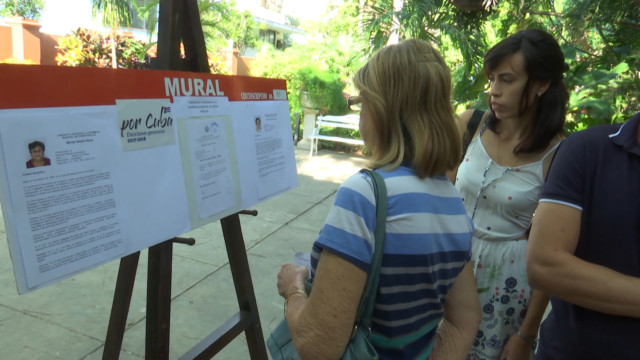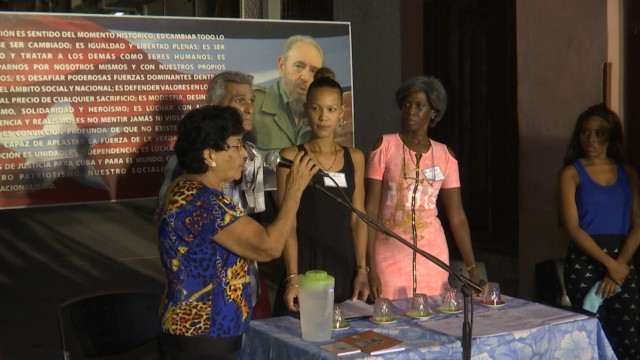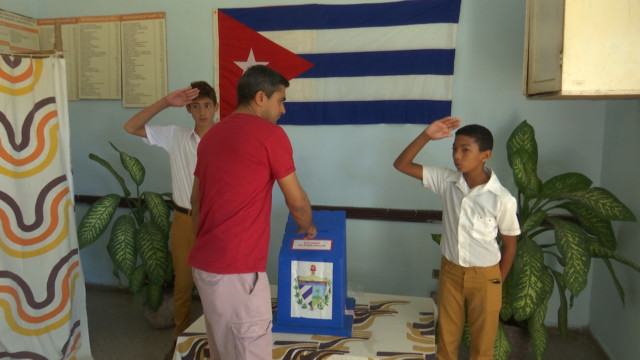More than eight million Cubans are expected to go to the polls on Sunday to elect a new legislative parliament – the National Assembly of People’s Power — as well as provincial assemblies.
There will be few surprises. There is only one candidate running in each of the 605 seats.

A show of hands to select candidates for the municipal elections.
But, on another level, there is anticipation here because when the Cuban Assembly meets for the first time on April 19, it will elect a new president.
Raul Castro has announced that he will step down, and for the first time in almost 60 years, there will not be a Castro as head of state.
CUBA’S ELECTORAL SYSTEM
Cuba has a unique electoral system. The first steps are transparent; the process then becomes more opaque and difficult to follow.
Elections here are not fought on political or other issues. There is no campaigning or rallies or TV spots.
Instead, each candidate has a single page biography posted in public places and in front of the polling stations.
The Cuban authorities say this creates a level playing field because candidates don’t depend on who has the largest financial contributions in order to win.
The latest election cycle began in September last year with thousands of street corner neighborhood block meetings where local residents selected, by a show of hands, their candidate to stand for the local municipal authority.
Here, there is more than one candidate for each seat. The voting, by secret ballot, took place in November.
One of the first jobs of the new municipal authorities is to select candidates for the provincial legislatures as well as the National Assembly.
This is where the National Candidature Commission steps in.
Around half of the National Assembly deputies must be elected members of the municipal authorities.
The Commission whittles down the list and decides who will stand and then goes on to nominate the other half of the 605 candidates.
The Commission is made up of state-backed social organizations including: Cuban Workers’ Federation, Committee for the Defense of the Revolution, Federation of Cuban Women, Union of Artists and Writers, the Students Federations and the National Association of Small Farmers.
Cuba is a one party political system but one doesn’t have to be a member of the communist party to be selected; many deputies are but not all of them.

Printed biographies of candidates in front of a polling station.
THE NEW NATIONAL ASSEMBLY
According the official newspaper of the Communist Party, Granma, of the 605 candidates:
• 90 percent were born after the revolution.
• Average age of the Assembly will be 49.
• 338 candidates (56 percent) are new and will sit for the first time.
• More than 40 percent are black or of mixed race.
• More than 53 percent are women.
According the Inter-Parliamentary Union, this would make Cuba one of only three countries in the world where woman are in the majority, the others being Rwanda 61 percent and Bolivia 53.1 percent.
CHOOSING THE NEW PRESIDENT
When the delegates meet for the first time on April 19, they will be presented with a list, also selected by the National Candidature Commission, of the 31 proposed members of the inner cabinet, the Council of State.
This list will indicate who is President of the Council plus the vice presidents. The deputies then vote, in secret, on the nominations.
At that point, the voters will officially know who has become the next president of Cuba.
To become president, you must be a deputy.
The daughter of Raul Castro, Mariela Castro, is in the National Assembly and has been nominated as a deputy for parliament.
She is best known as the country’s leading campaigner on LGBT rights, and there is no indication that she has any interest in the presidency.
Alejandro Castro Espín, Raul’s only son, is a powerful political and military figure, a colonel in the Ministry of Interior, but he is not on the list of candidates so can’t be legally considered for president.
The man widely expected to replace Raul Castro is the 57-year-old First Vice President, Miguel Diaz-Canel.

Miguel Diaz-Canel is expected to become the next President of Cuba.
An electronics engineer by training, he came up through the ranks of the communist party and at 31 became a provincial party leader, the U.S. equivalent of a state governor. He went on to become one of the youngest members ever appointed to the Politbureau, the party’s top decision-making body.
Díaz-Canel has a reputation for being liberal on issues such as greater press freedom, gay rights and access to the internet. Yet he has also been recorded taking a very hard-line on political dissent and other issues.
Just what his powers will be if he does become president is hard to judge. Raul Castro will stay on as head of the Communist Party, which remains the country’s guiding force.
It does, though, mark an important decentralization of power. For the first time, the head of the party and the president will not be the same person.

Street meetings as residents select local candidates.
 CGTN America
CGTN America
 More than 8 million Cubans will vote on March 11th.
More than 8 million Cubans will vote on March 11th.
